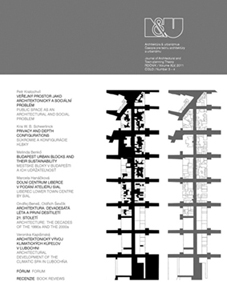VEŘEJNÝ PROSTOR JAKO ARCHITEKTONICKÝ A SOCIÁLNÍ PROBLÉM
PUBLIC SPACE AS AN ARCHITECTURAL AND SOCIAL PROBLEM
Author(s): Petr KratochvílSubject(s): Cultural Essay, Political Essay, Societal Essay
Published by: Historický ústav SAV, v. v. i.
Keywords: city; architecture; space; place; street; square; public; society; people; activities
Summary/Abstract: The goal of the present study is the depiction, description and critical evaluation of developmental tendencies in the evolution of architecture in the previous two decades. Taking as its starting point the characterisation of the era as one of exceptionally late modernity, it stresses primarily the increased speed in technical development and the reflection of this phenomenon in culture and architecture – in which the authors take up the conclusions of the Czech architect, historian and architectural theorist Dalibor Veselý, primarily active in Britain. (Architecture in the Age of Divided Representation – the only such text linking approaches from architectural theory to those in philosophy, yet nonetheless a demanding, even hermetic text), or Georg Franck and Dorothea Franck (Architektonische Qualität. München, Editition Akzente, Hanser Verlag 2008), where the category of architectural quality is remarkably clarified, as well as the highly conceptual (yet accessible for the practicing architect) work of the Russian theorist I. A. Dobritsyna (Ot postmodernizma-k nelinějnoj architěkture: Architěktura v kontěkste sovremennoj filosofii i nauki. Moskva, Progress-Tradicija 2004) and other works. Viewed in a historical perspective: architecture was always an autonomous discipline, in which there persisted a balance between technology and culture: architecture never succumbed to the status of an offshoot of modern technology but preserved within itself what, in each culture, belonged to place and tradition. In culture, we have our existential connection to the “natural world”, culture thus balanced the pressure of the technical domination of the world through the ‘unifying role’ of architecture. The architect of the late Modern era, however, can no longer rely upon culture to balance the technical aspect with the absolute security that he or she had previously, for culture, to the late-Modern era, is no less suffused with the mindset of calculation. Yet it still holds true that the building is the subject that anchors the human individual in the world, and if this does not come about, we find ourselves living in a world of the ‘weakened home’ – in which even lawyers speak of the ‘consumption’ of law and we ourselves merely ‘consume’ our architecture and our lives. In the diverse branching of the mainstream of modernity, in contemporary architecture (characterised by the ‘loss of balance’) there has been, according to the authors, an uncovering of the highly varying yet in their own way equally onesided, complementary and competing reactions to entropy, to changes in the design and construction technologies, and changes in economic rationality. In this sense, the authors address the imperative question of minimalism, the ‘new reduction’ (J. Pawson, P. Zumthor, J. Asse et al.), the approach that cultivates the values of a simple building yet one rich in experience, an opposition towards the architecture of entertainment. Can this success of reducti
Journal: Architektúra & Urbanizmus
- Issue Year: 45/2011
- Issue No: 3-4
- Page Range: 144-165
- Page Count: 32
- Language: Czech

